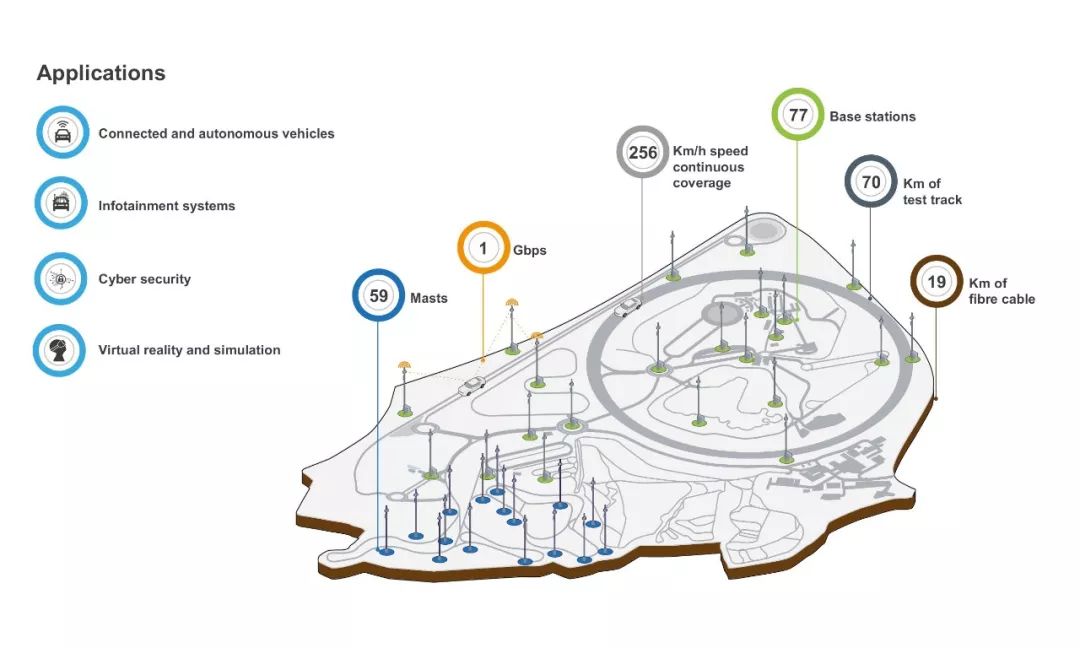 英国 Millbrook 试验场的“碗”型高速道路是 5G 技术开发的重要特征。(图片来源:Millbrook 试验场)
英国 Millbrook 试验场的“碗”型高速道路是 5G 技术开发的重要特征。(图片来源:Millbrook 试验场) 英国 Millbrook 试验场的AutoAir 项目将为 5G 通信技术登陆自动驾驶汽车做出重大贡献。(图片来源:Millbrook 试验场)
英国 Millbrook 试验场的AutoAir 项目将为 5G 通信技术登陆自动驾驶汽车做出重大贡献。(图片来源:Millbrook 试验场)
目前,英国 Millbrook 试验场已经正式启动了 AutoAir 自动驾驶汽车联盟的 5G 蜂窝测试基础设施,用于自动驾驶车辆的开发与测试。这套新设施可以为自动驾驶汽车开发商提供一套低延时的广域无线设备,据称可无缝覆盖位于伦敦以北 50 英里(80 公里)的整个场区。
Millbrook 试验场表示,“5G通信能力对 SAE L3 级到 L5 级自动驾驶汽车测试至关重要,只有具备这种高速实时连接,自动驾驶汽车才能将现实世界与模拟决策的结果进行比较。”
开发人员将能够模拟弱信号和强信号,并借助试验场中的丘陵等地貌理解各类地形对信号的影响,而且还能同时访问测试期间生成的所有数据。AutoAir 自动驾驶汽车联盟由 Airspan Networks 公司启倡,允许自动驾驶汽车开发人员使用增强和虚拟现实技术,为车辆创建虚拟事件,从而在安全环境下完成多种测试,甚至包括一些危险的边缘场景。
Millbrook 试验场 AutoAir项目所采用的技术基于运行于“中性宿主(neutral host)”的 4G和5G 小型蜂窝网络单元。Airspan Networks 公司首席战略官 Paul Senior 表示,“AutoAir 项目是世界上最雄心勃勃的 5G 测试平台和站点之一,现已完成超密集小型蜂窝网络的部署,可以提供超高网络容量,帮助开发人员轻松探索丰富的 CAV 使用场景。”
Millbrook 试验场围绕园区高速公路共建设了 77 个小基站(使用 2.3 GHz 和 3.7 GHz 频段)和 22 个毫米波接入点(即 30 GHz 到 300 GHz 频段),安装了 59 根天线杆(38 根用于小基站、11根用于毫米波接入点、10 根用于沿山公路的毫米波网状回程网),共使用电缆 19 公里(11.8 英里)。
支持时速 160 mph 所需的蜂窝网络覆盖
Millbrook 试验场的全新通信系统可以提供:高达 1 Gbps的实时连接;“碗型”道路周围在车速 256 km/h (160 mph) 时仍可保证高速网络连接;使用 4G 长期评估访问(一旦商用设备到位,该网络还可支持 5G NR 通信);及多接入边缘计算能力(MEC),并确保所有数据均不会流出试验场。
Millbrook 试验场还可以为开发人员提供开源参考车辆。这些参考车辆经过编程可模拟多种车辆以协助自动驾驶软件的开发,还可以模拟一系列“软目标”从而更好地反映自动驾驶汽车的真实工作环境。此外,试验场还可以为园区内的测试车道提供精度高达 1 mm 的精密数字模型,以及同时适用于真实环境和虚拟环境开发的模拟器。
网络安全一直是自动驾驶汽车研发的重点问题,5G 测试平台可模拟移动网络中断的情况,以测试软件、车辆和基础设施的抗干扰能力。此外,这种开放接入网络还可以通过“切片”允许用户在单个网络基础设施上工作,帮助测试各种网络中断和连接问题。
除了 Airspan Networks 公司,AutoAir 联盟的其他成员还包括迈凯伦应用技术公司(McLaren AppliedTechnologies)、Blu Wireless Technology、萨里大学 5G 创新中心、Dense Air、Quortus及 Celestia Technologies Group。
欧洲另一试验场瑞典 AstaZero 中心已成为欧洲 NCAP 认证的主动安全和自动驾驶系统测试场地,目前由瑞典研究所(RISE)和查尔莫斯理工大学共同所有。
Millbrook Proving Ground in the U.K. has officially launched the AutoAir consortium’s 5G cellular testing infrastructure for autonomous vehicle (AV) development. The new facility at Millbrook provides AV developers access to a low-latency, wide-area wireless infrastructure billed to work seamlessly across the entire sprawling test facility 50 miles (80 km) north of London.
Millbrook said, “This capability is crucial for the validation and testing of SAE Level 3 to Level 5 autonomous vehicles, which require high-speed real-time connectivity to compare real-world outcomes with decision-making simulation.”
Developers will be able to simulate weak and strong cell signals and understand the impact of hills and other terrain—all within Millbrook’s grounds—while having access to all data generated during testing. The AutoAir consortium is led by Airspan Networks and enables AV developers to create virtual events using augmented and virtual reality for vehicles on track, to test in safety scenarios right up to edge cases.
The technology used at Millbrook is based on 4G and 5G small cells that operate on a “neutral host” basis. “AutoAir at Millbrook is one of the most ambitious 5G testbeds and trials sites in the world. The project has now completed the deployment of a hyper-dense small cell network that delivers ultra-high capacities which enables a range of new CAV use cases to be explored,” said Paul Senior, chief strategy officer at Airspan Networks.
The Millbrook mobile network facility comprises 77 small-cell base stations (using 2.3 GHz and 3.7 GHz spectrum) and 22 millimeter-wave access points (millimeter-wave is the spectrum from 30 GHz to 300 GHz) around Millbrook’s banked, high-speed road circuit. There are 59 masts, 38 for the small cell base stations and 11 for the millimeter-wave access points, plus 10 for the millimeter-wave mesh backhaul along a hill route. Some 19 km (11.8 miles) of fiber-optic cable is installed.
Cellular coverage at 160 mph
The site’s new communications systems provide up to 1 Gbps real-time connectivity; up to 256 km/h (160 mph) continuous coverage capability around the high-speed bowl; access using 4g long-term evaluation—the network capable of supporting 5G New Radio (NR) when commercial devices become available—and secure Multi-access Edge Computing (MEC) with the assurance that data does not leave Millbrook’s environs.
The Millbrook facility offers access to open-source reference vehicles that can be programmed to emulate a range of vehicles for AV software development, and “soft targets” for real-world AV requirements. It also can provide a digital model of the facility’s test tracks with 1 mm surface accuracy for vehicle simulation, as well as a simulator suite for both physical and virtual development.
With cybersecurity a continuing concern for AVs, the 5G testbed can be used to simulate mobile-network disruption and connectivity to test software, vehicle and infrastructure resilience to interference. And an open-access network, with slicing to enable users to work on a single network infrastructure, facilitates testing involving various network disruption and connectivity situations.
Together with Airspan Networks, the AutoAir consortium includes McLaren Applied Technologies; Blu Wireless Technology; The 5G Innovation Center, University of Surrey; Dense Air; Quortus and Celestia Technologies Group.
Another proving grounds in Europe, the Swedish test facility AstaZero, now is accredited by Euro NCAP to perform tests of active safety systems and automated driving. It is owned by Research Institutes of Sweden, (RISE) and Chalmers University of Technology.
Author: Stuart Birch
Source: Autonomous Vehicle Engineering
等级
打分
- 2分
- 4分
- 6分
- 8分
- 10分
平均分
